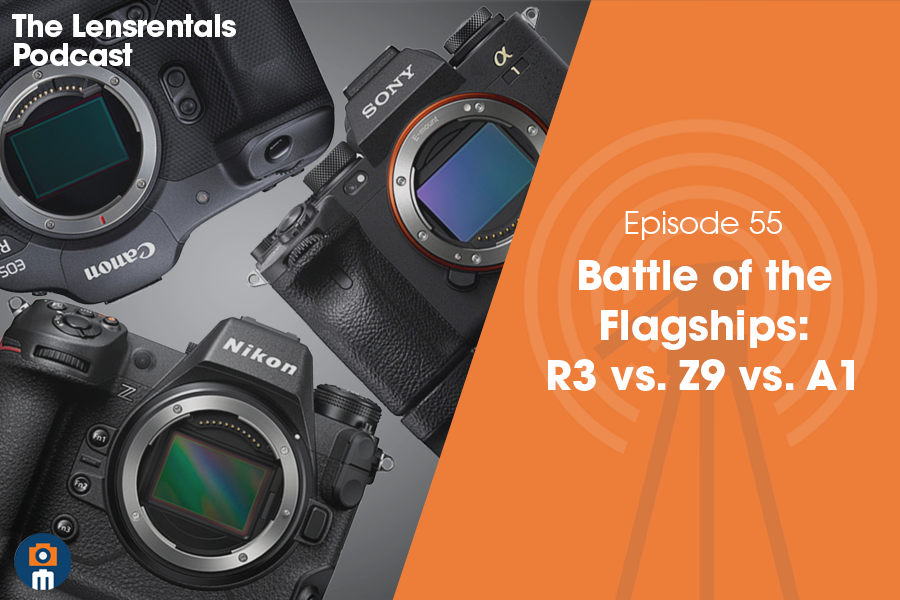Podcast Episode
The Lensrentals Podcast Episode #55 – Battle of the Flagships: Canon R3 vs. Nikon Z9 vs. Sony A1

Each week Roger Cicala, founder of Lensrentals.com, hosts conversations about the art and science of capturing images. From photography to videography, film, history, and technology, the show covers a wide range of topics to educate and inspire creators of all kinds.
Battle of the Flagships: Canon R3 vs. Nikon Z9 vs. Sony A1
The Lensrentals Podcast is finally back, and today we’re tackling questions that many people have been wondering about – comparing the three latest flagships from the Canon, Nikon, and Sony. Join Ryan Hill, Joey Miller, and Zach Sutton as they walk through all the features of each camera, to determine which one is best for each use case.
Though the Canon R3 was released in late November, the Nikon Z9 was released in December, and the Sony A1 was released in early 2021, supply has been incredibly limited on all three systems. As such, many people haven’t had the opportunity to get the cameras in their hands, leaving us with a lot of questions. In this episode of the Lensrentals Podcast, listen in as we try to answer all your questions, and share our opinions on which one is our personal favorite.
In this slightly longer-than-usual episode, we cover a lot of topics on each of these cameras, and a lot of features. And while we deduct many of the specialties of each camera, such as Eye AF on the Canon R3, we can’t cover everything. So below is a table with some of the features worth highlighting.
| Canon R3 | Nikon Z9 | Sony A1 | |
|---|---|---|---|
| Price | $5999 | $5500 | $6500 |
| Sensor Resolution (Effective Pixels) | 24 megapixels | 46 megapixels | 50 megapixels |
| ISO Range | ISO 50-204800 | ISO 32-102400 | ISO 50-102400 |
| CIPA image stabilization rating | 8 Stops | 6 Stops | 5.5 Stops |
| Number of focus points | 1053 Points | 493 Points | 759 Points |
| Back Screen Resolution | 4,150,000 | 2,088,960 | 1,440,000 |
| Viewfinder Resolution | 5,760,000 | 3,686,400 | 9,437,184 |
| Maximum Shutter Speed | 1/64000 sec (electronic) | 1/32000 sec (electronic) | 1/32000 sec (electronic) |
| Flash X sync speed | 1/250 sec | 1/200 sec | 1/400 sec |
| Continuous drive | 30.0 fps | 30.0 fps | 30.0 fps |
| Max Video Resolution | 6K RAW up to 60p | 8K 10-bit 4:2:2 up to 30p | 8K 10-bit 4:2:0 up to 30p |
| Battery Life (CIPA) | 760 Shots | 740 Shots | 530 Shots |
Among some of the more interesting features discussed in this episode is Nikon’s use of an electronic shutter through its entire shutter speed range. Does this mean that its flash sync speed could be increased with a firmware update? Theoretically, yes…but it would also be dependent on the flash duration of each specific flash brand. We also discuss Canon’s incredible Eye AF system. Not to be confused with autofocus which detects the eye of your subject, Eye AF actually reads where your eye is looking in the viewfinder and tracks your eye to focus on specific objects and subjects. We can’t help but think this would be incredibly valuable when shooting high-speed subjects like sports or birding.
Gear Mentioned In this Episode:
Timestamps
The Lensrentals Podcast is a production of Lensrentals, founded by Roger Cicala. Our production staff includes Drew Cicala, Ryan Hill, Sarah McAlexander, SJ Smith, Julian Harper, John Tucker, and Zach Sutton. Other contributors include Roger Cicala, Joey Miller, Ally Aycock Patterson, Joshua Richardson, and Philip Robertson.
Thanks to Jacques Granger for our theme song.
Submit a topic idea, question, or comment, leave us a voicemail at 901-609-LENS, or send us an email at podcast@lensrentals.com.
Facebook
YouTube
Instagram
TikTok
Twitter
Pinterest
Author: Lensrentals
Articles written by the entire editorial and technical staff at LensRentals.com. These articles are for when there is more than one author for the entire post, and are written as a community effort.
-
achelseaphotographer
-
elbows2
-
glennck
-
saynotocoakley
-
Kan
-
Sean T
-
Mike Jackson
-
Stephen K Mack
-
Liam Kelley
-
Athanasius Kirchner
-
Peter Clayton




